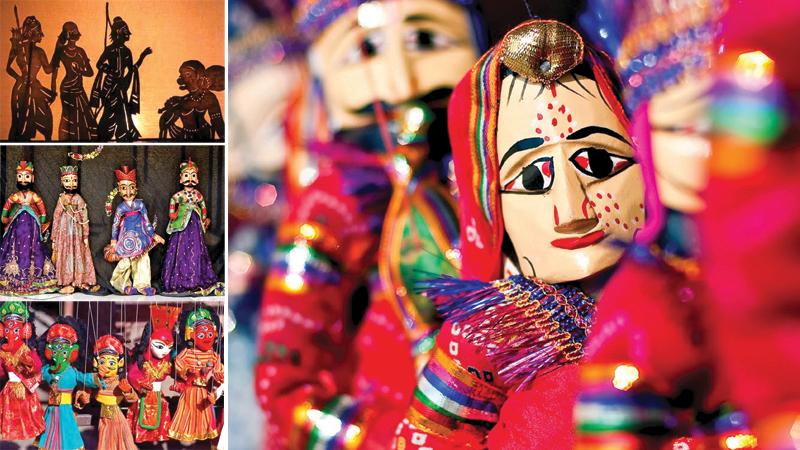
The art of puppetry originated in India several centuries ago as an entertainment art form and was considered as one of the important art forms in the Indian theatre. However, with the arrival of modern multimedia entertainments, it has lost its vitality.
Puppetry is popular the world over, and is considered as an important entertainment art form. Puppetry reflects the country’s culture, traditions and customs. Even some contemporary issues are enacted through puppetry. The names of these puppet shows vary from region to region and from place to place. Puppetry in India has derived its theme from various religious epics. It imparts and cultivates various religious values and philosophy.
In the early years puppeteers moved from place to place to earn their livelihood. Yet it is considered as a folk art. These puppets are manipulated by strings, shadow, rod and glove. Based on this the puppets are categorised into four varieties, namely, string, shadow rod and glove puppets. Normally in string-puppet shows, the strings are tied to various limbs of the puppets. Strings are used to manipulate the puppets even today.
Initially, puppetry was for entertainment purposes only but later it gained more popularity and recognition among the masses. Originally, the puppets were made of leather, and were called Tholpavai Attam or Bommalattam. Tholpavai means dolls made out of leather. In Andhra Pradesh, it is called Tholu Bommalattam. Later, puppets were also made from other materials such as cloth, light wood and paper pulp. But today some puppets are made with heavy plastic or rubber. The movements of puppets are always accompanied by dialogue, narration, appropriate vocal and instrumental music. Different Indian States have named the puppetry diversely.
Puppet making is an exceptional art. They bring out the characters with appropriate figures and facial expressions, and costumes and ornaments are used to adorn the puppets. In addition, external voice support and suitable music are given to the puppets to reveal the theme of the story. Earlier, the puppeteers travelled to various places to earn their livelihood. However, it was considered a folk art.
In Tamil Nadu, puppetry was originally performed in the royal courts in Tanjore. This art form which originated during the Tanjore regime was very popular in the Tanjore district. Initially, mere platforms were used to display the art, but now covered stages are used and puppeteers stand close to the stage to manipulate the puppets.
The names and nature of the puppet shows vary from region to region. For instance, in Andhra Pradesh puppets were made out of leather and manipulated with sticks.
Another branch of development in the Indian puppetry is the shadow puppet show. Andhra Pradesh is popular for shadow puppetry and is still persevered by certain communities.
Similarly, another shadow puppet show was performed in the modern Kerala State, called Pavai Koothu of Malabar. Sometimes the shadows of the puppets are allowed to fall on the back curtain. In Tamil Nadu, this type of puppetry is called Nillal Attam (shadow puppet show). Puppet shows are popular among the rural folk even today and take place at night.
In Rajasthan, puppetry was called Kathputali. They believed that their ancestors were responsible for the origin and development of Indian puppetry. Eventually, they migrated to different States and introduced this art form in those areas.
Beautiful puppets are made with an aesthetic touch. In the early days the rational theme of the story was the life history of a ruler named King Amar Singh who ruled some hundred years ago.
Subsequently, numerous techniques were adopted and introduced to keep the interest of the audience alive.
In Orissa, the Odissi puppetry was founded on the Radha and Krishna themes, based on the Vaishnava cult. Sometimes folklore or popular legends are also selected for puppet shows. The size, shape and even the figure of the puppets differ from State to State.
In Bengal, it is strictly dedicated to Goddess Kali and performed during special religious functions and festivals of the temples. Some of the puppetry was vested in the hands of a few classes or communities. A few puppet shows have gained popularity within a particular region due to factors such as linguistic and cultural differences.
Strings are mostly used to activate the puppets, while modern technology is also added giving different sounds and hues. With the arrival of modern technological innovations such as television, video and home video systems, traditional puppetry has lost its vitality among the masses. Yet, in the villages, it has some entertainment value.
To some extent, puppet shows have gained popularity through the visual media. Now various socio-political themes and contemporary subjects are selected for television puppet shows to impart and spread various ideas among viewers.
By watching television puppet shows, the younger generation can gather some idea about this traditional folk art. At present, in some shows, the puppets are activated by remote control equipment.
The Indian puppetry has established itself in the South East Asian cultural scene, mainly in Java and Bali. Wayang Golek is a popular puppet show in this region. Ancient popular Indian epics, such as Ramayana and Mahabharata are the main selective themes for these puppet shows.
